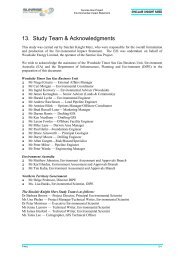Appendix D Terrestrial and Aquatic Biodiversity - Environment ...
Appendix D Terrestrial and Aquatic Biodiversity - Environment ...
Appendix D Terrestrial and Aquatic Biodiversity - Environment ...
You also want an ePaper? Increase the reach of your titles
YUMPU automatically turns print PDFs into web optimized ePapers that Google loves.
SZ247: Bat survey from the Western Desert Resources Towns River project area, NT<br />
A single bat species may produce more than one call type (e.g. search phase calls,<br />
approach phase calls, clutter calls) that might suggest the presence of more than one<br />
species. With sufficient experience of related species, it is generally possible for a bat<br />
echolocation specialist to take this into account, <strong>and</strong> to base identifications on the<br />
typically more diagnostic search phase calls.<br />
Absolute abundance of each species or call type at a site cannot be estimated from bat<br />
detector recordings because it is not possible to distinguish between relatively few bats<br />
passing the detector but contributing many calls, <strong>and</strong> a larger number of individuals<br />
passing the detector with each contributing relatively few calls.<br />
Finally, it should be noted that in all acoustic surveys the 'detectability' of each species<br />
is influenced by several factors such as bat detector model (microphone sensitivity<br />
profile <strong>and</strong> zone of reception, mode of recording, <strong>and</strong> the type of built-in preamplification<br />
<strong>and</strong> filter components), atmospheric conditions <strong>and</strong> characteristics of echolocation calls.<br />
Species that produce ultra-high frequency (> 100 kHz) calls or those that produce calls<br />
with low amplitude (e.g. long-eared bats Nyctophilus spp.) will have relatively short<br />
detection distances, which will lead to their being under-represented or even missed<br />
altogether in an acoustic survey. The detectability of different call types is also<br />
influenced by atmospheric conditions, most notably relative humidity <strong>and</strong> temperature<br />
that act together to attenuate ultrasound, the effects of which are dramatic at higher<br />
frequencies (e.g. Armstrong <strong>and</strong> Kerry 2011). Thus, acoustic detection represents<br />
only one component of a comprehensive survey approach for bats, <strong>and</strong> targeted effort<br />
is required for species with lower acoustic detectability.<br />
3.5 Trapping<br />
Not all bat species in the Northern Territory can be identified reliably from their echolocation<br />
calls (Milne 2002), <strong>and</strong> there are several species that must be captured in order to make an<br />
unambiguous identification. In addition, trapping is recommended to obtain a more complete<br />
inventory of bats in a given assemblage because of several biases in the acoustic survey<br />
technique (e.g. Duffy et al. 2000; see also point 4 in section 3.4). Trapping was conducted<br />
on four of the five available survey nights (31/1/2012 – 3/2/2012) using mist nets <strong>and</strong> harp<br />
traps. This activity was conducted under a permit issued by the Northern Territory Parks <strong>and</strong><br />
Wildlife Commission (permit number 43654), <strong>and</strong> all procedures were approved by the Animal<br />
Ethics Committee of The University of Adelaide (project number S-2011-195).<br />
Mist nets were placed over pools <strong>and</strong> rivers to maximise the chance of capturing bats.<br />
Previously Milne et al. (2005) <strong>and</strong> Milne (2006:79) had identified greater richness of bats in<br />
riparian <strong>and</strong> adjacent areas, <strong>and</strong> it was anticipated that high flying species such as<br />
Saccolaimus would be more likely to encounter a mist net set over water than one set in open<br />
woodl<strong>and</strong>. Three mist nets were arranged in an 'N' configuration over a small creek<br />
(Melaleuca viridflora +/- Eucalyptus microtheca Low Open Woodl<strong>and</strong>; site M01; 31/1/2012);<br />
three nets were strung across a wide flowing river in the south-east corner of the project area<br />
(Melaleuca viridflora Low Open Woodl<strong>and</strong>; site M02; 1 – 2/2/2012); <strong>and</strong> a single net was<br />
strung across a pool in the Towns River (Melaleuca nervosum Low Open Woodl<strong>and</strong>; site M03;<br />
3/2/2012). Vegetation habitats are defined as per the vegetation survey described in the<br />
Page 10 of 33



